- 121.分布式文档系统_Elasticsearch上机动手实战演练bulk批量增删改_bulk operation has failures
- 2Git:生成ssh,并设置ssh链接_git 生成ssh
- 3快速应用开发_快速应用开发(rad)
- 4MP-SPDZ-V0.3.2(二)模拟三方秘密分享(SS)求和_mp—spdz
- 5NLP(六十三)使用Baichuan-7b模型微调人物关系分类任务_firefly-baichuan-7b
- 6gvim自动补全设置_在gvim中编辑verilog怎么设置begin end的对齐或者打always自动补全
- 7安装PCL点云库官方文档至本地计算机_点云库pcl1.11官方文档
- 8处理el-table大数据卡顿的问题,包含tree型数据格式_el-table 100条数据缩放页面后卡顿
- 9【AI视野·今日CV 计算机视觉论文速览 第253期】Mon, 25 Sep 2023_lmc: large model collaboration with cross-assessme
- 10python--字典版学生成绩管理系统_python字典-学生成绩统计
机器学习----混淆矩阵(Confusion Matrix)
赞
踩
混淆矩阵(Confusion Matrix)
假设有一个算法,其预测某种癌症的准确率为99.9%。这个算法好吗?
99.9%的准确率看上去很高,但是如果这种癌症本身的发病率只有0.1%,即使不训练模型而直接预测所有人都是健康人,这样的预测的准确率也能达到99.9%。 更极端的情况,如果这种癌症本身的发病率只有0.01%,这算法预测的准确率还不如直接预测所有人都健康。 对于极度偏斜的数据(癌症患者的人数和健康人数量差别特别大)(skewed data),用准确率评价分类算法好坏有局限性.]
解决方法:混淆矩阵
工具:混淆矩阵,以二分类为例
0 - Negative - 阴性, 1 - Positive - 阳性
1是我们关注的部分。
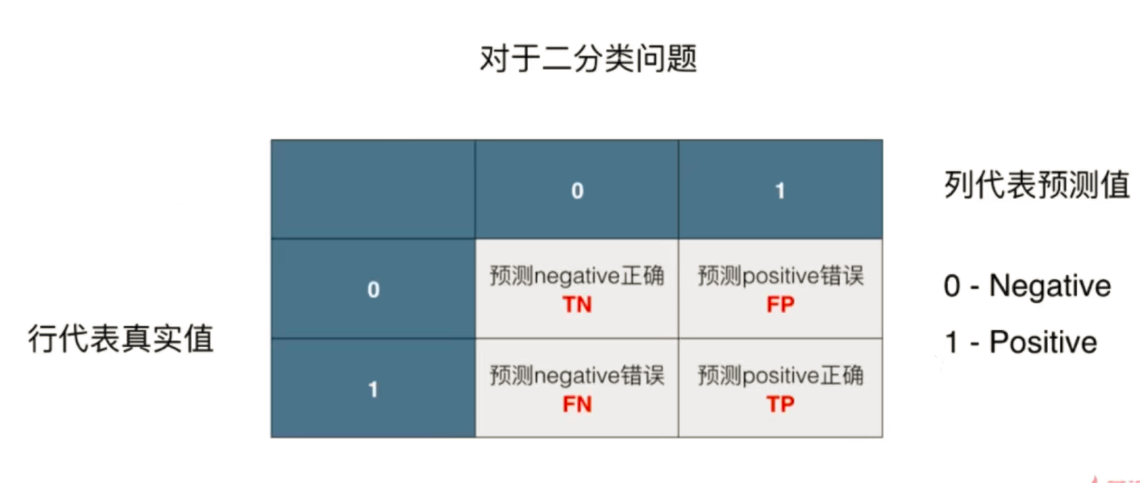
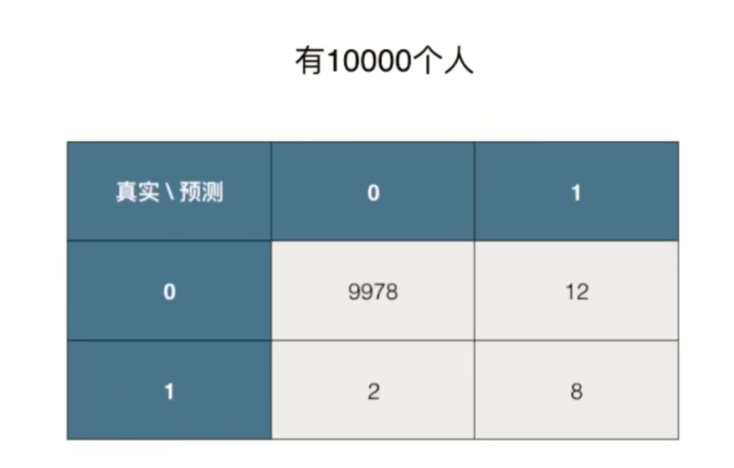
00位置代表有9978人真实没患癌症; 模型预测9978人也没患癌症
01位置代表有12人没患癌症; 模型却预测12人患了癌症
11位置代表有2人患了癌症; 模型却预测2人没患癌症
12位置代表有8人患了癌症; 模型预测8人患了癌症
精确率和召回率
精准率 precision = TP / (TP + FP)
召回率 recall = TP / (TP + FN)
在有偏数据中,将1作为真正关注的事件
精准率:预测的关注事件(1)中预测对了的概率
 ### 召回率: 表示 我们算法在已经发生的事件中正确预测个数的比率。
### 召回率: 表示 我们算法在已经发生的事件中正确预测个数的比率。
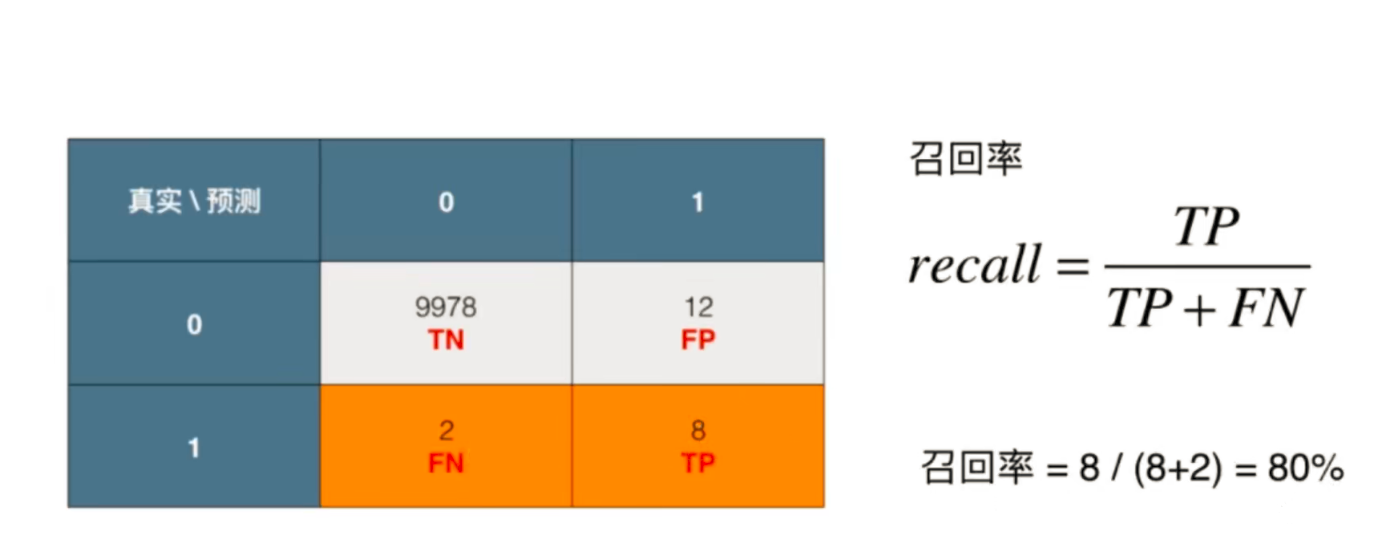
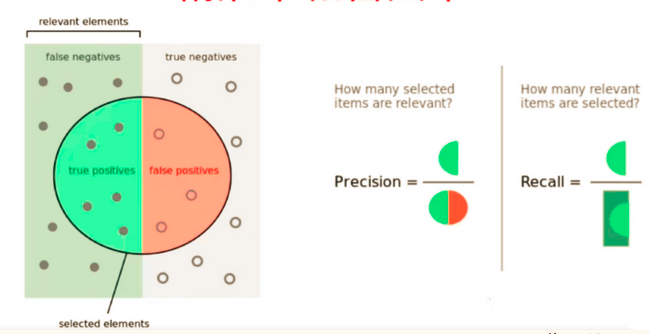
使用混淆矩阵的好处
回到之前列举的癌症预测案例, 如果某种癌症的发病率为0.1%,那么预测所有人都健康的模型,虽然准确率达到99.9%。但精准率没有意义,召回率为0,可见这个模型是个无效的模型, 所以混淆矩阵可以作为季度偏斜的数据的评价指标
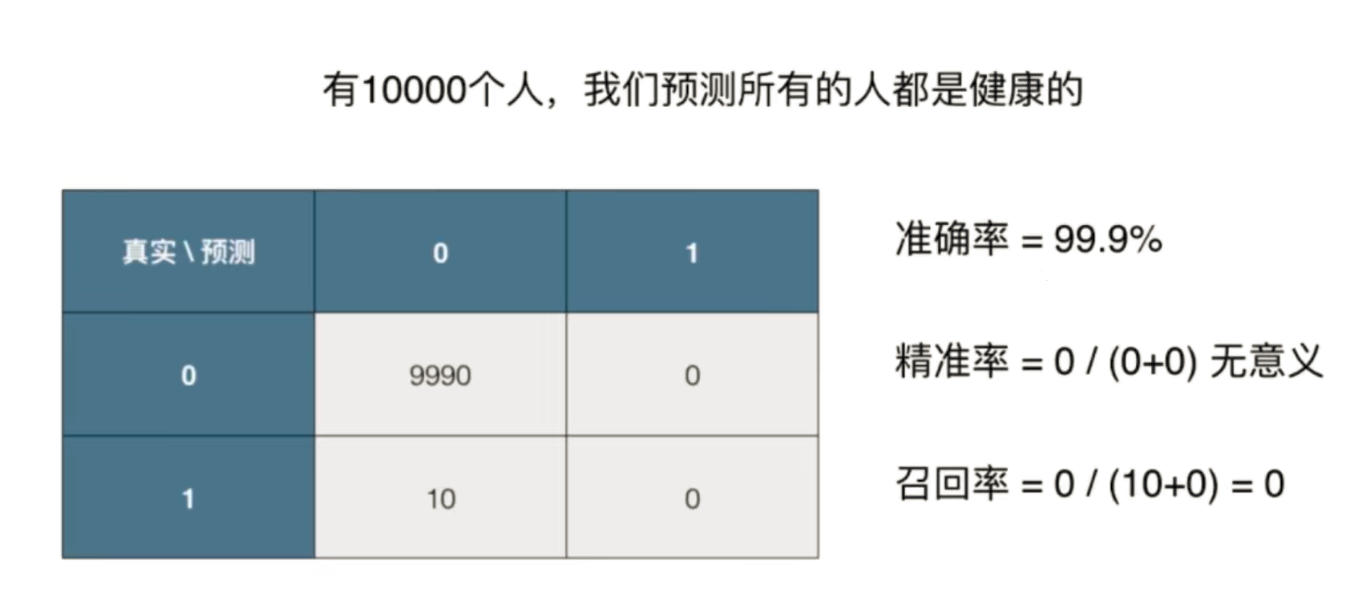
实现混淆矩阵、精准率、召回率
import numpy as np from sklearn import datasets digits = datasets.load_digits() X = digits.data y = digits.target.copy() y[digits.target==9] = 1 y[digits.target!=9] = 0 # 产生极度偏斜的数据 from sklearn.model_selection import train_test_split X_train, X_test, y_train, y_test = train_test_split(X, y, random_state=666) from sklearn.linear_model import LogisticRegression log_reg = LogisticRegression() log_reg.fit(X_train, y_train)
- 1
- 2
- 3
- 4
- 5
- 6
- 7
- 8
- 9
- 10
- 11
- 12
- 13
- 14
- 15
- 16
- 17
准确度
log_reg.score(X_test, y_test)
- 1
输出:0.9755555555555555
混淆矩阵
y_log_predict = log_reg.predict(X_test) def TN(y_true, y_predict): assert len(y_true) == len(y_predict) return np.sum((y_true == 0) & (y_predict==0)) # 注意这里是一个‘&’ TN(y_test, y_log_predict) # 403 def FP(y_true, y_predict): assert len(y_true) == len(y_predict) return np.sum((y_true == 0) & (y_predict==1)) FP(y_test, y_log_predict) # 2 def FN(y_true, y_predict): assert len(y_true) == len(y_predict) return np.sum((y_true == 1) & (y_predict==0)) FN(y_test, y_log_predict) # 9 def TP(y_true, y_predict): assert len(y_true) == len(y_predict) return np.sum((y_true == 1) & (y_predict==1)) TP(y_test, y_log_predict) # 36 def confusion_matrix(y_true, y_predict): return np.array([ [TN(y_true, y_predict), FP(y_true, y_predict)], [FN(y_true, y_predict), TP(y_true, y_predict)] ]) confusion_matrix(y_test, y_log_predict)
- 1
- 2
- 3
- 4
- 5
- 6
- 7
- 8
- 9
- 10
- 11
- 12
- 13
- 14
- 15
- 16
- 17
- 18
- 19
- 20
- 21
- 22
- 23
- 24
- 25
- 26
- 27
- 28
- 29
- 30
- 31
- 32
- 33
输出结果:
array([[403, 2], [ 9, 36]])
精准率
def precision_score(y_true, y_predict):
tp = TP(y_true, y_predict)
fp = FP(y_true, y_predict)
try:
return tp / (tp + fp)
except: # 处理分母为0的情况
return 0.0
precision_score(y_test, y_log_predict)
- 1
- 2
- 3
- 4
- 5
- 6
- 7
- 8
- 9
def recall_score(y_true, y_predict):
tp = TP(y_true, y_predict)
fn = FN(y_true, y_predict)
try:
return tp / (tp + fn)
except:
return 0.0
recall_score(y_test, y_log_predict)
- 1
- 2
- 3
- 4
- 5
- 6
- 7
- 8
- 9
- 10
输出结果:0.8
scikit-learn中的混淆矩阵、精准率、召回率
from sklearn.metrics import confusion_matrix
confusion_matrix(y_test, y_log_predict)
from sklearn.metrics import precision_score
precision_score(y_test, y_log_predict)
from sklearn.metrics import recall_score
recall_score(y_test, y_log_predict)
- 1
- 2
- 3
- 4
- 5
- 6
- 7
- 8
0.8
F1 score
对于极度偏斜的数据,使用指标精准率和召回率都优于使用指标分类准确度。
但精准率和召回率是两个指标。如果一个算法的精准率和召回率表现不同,该如何取舍这两个指标?
解决方法1:视具体场景而定。
有时我们注重精准率,比如股票预测,我们希望预测股票为升结果都是准确的(否则可能亏钱),而不在意错过另一些错过的股票上升的机会(错过一些赚钱的机会)。
有时我们注重召回率,比如病人诊断。我们希望得病的人都能识别出来(否则这些人可能会病情恶化),而有一些没得病的人被错误地识别出来没有关系(这些人做进一步检查即可)。
解决方法2:同时关注精准率和召回率,即新指标:F1 score
指标:F1 score
F1 score是precision和recall的调和平均值。
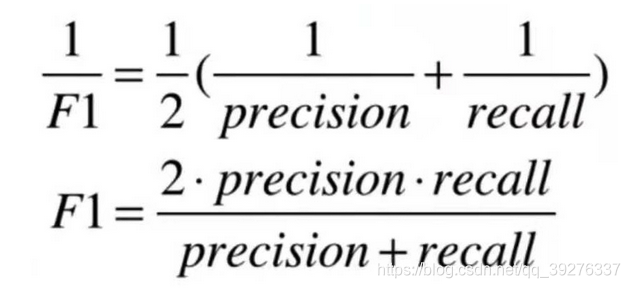
调和平均值的特点:如果precision和recall非常不平衡,则F1 score也是比较低的。只有两者都高,F1 score才会高。
F1 score的取值范围:[0, 1]
def f1_score(precison, recall):
try:
return 2*precison*recall /(precison + recall)
except:
return 0.0
- 1
- 2
- 3
- 4
- 5
precision和recall取不同的值对f1_score的影响

F1 score来评价手写数字的识别效果
import numpy as np from sklearn import datasets digits = datasets.load_digits() X = digits.data y = digits.target.copy() y[digits.target==9] = 1 y[digits.target!=9]= 0 # 产生极度偏斜的数据 from sklearn.model_selection import train_test_split X_train, X_test, y_train, y_test = train_test_split(X, y, random_state=666) from sklearn.linear_model import LogisticRegression log_reg = LogisticRegression() log_reg.fit(X_train, y_train) y_log_predict = log_reg.predict(X_test) from sklearn.metrics import accuracy_score, mean_squared_error, confusion_matrix from sklearn.metrics import precision_score, recall_score precison = precision_score(y_test, y_log_predict) recall = recall_score(y_test, y_log_predict) f1_score(precison, recall)
- 1
- 2
- 3
- 4
- 5
- 6
- 7
- 8
- 9
- 10
- 11
- 12
- 13
- 14
- 15
- 16
- 17
- 18
- 19
输出:0.8674698795180723
对有偏数据,指标F1 score优于分类准确度。
Precision-Recall平衡
我们总是希望精准率和召回率这两个指标都尽可能地高。但事实上精准率和召回率是互相矛盾的,我们只能在其中找到一个平衡。
以逻辑回归为例来说明精准率和召回率之间的矛盾关系,以下是逻辑回归的公式:
在这里决策边界是以0为分界点,如果把0改成一个自定义的threshold,threshold的改变会平移决策边界,从而影响精准率和召回率的结果。
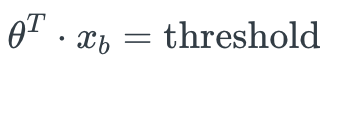
threshold是怎样影响精准率和召回率的

如图,图中的直线代表决策边界,决策边界右边的样本分类为1,决策边界左边的样本分类为0。图中五角星为实际类别为1的样本,0为实际类别为0的样本。
如果以0为分界点,精准率 = 4/5 = 0.0,召回率 = 4 / 6 = 0.67
分界点往右移,则精准率提升,召回率降低。
分界点往左移,则精准率下降,召回率提升。
下面使用LR对手写数字分类的例子来说明分界点移动对精准率和召回率的影响
# 数据 import numpy as np from sklearn import datasets digits = datasets.load_digits() X = digits.data y = digits.target.copy() y[digits.target==9] = 1 y[digits.target!=9] = 0 from sklearn.model_selection import train_test_split X_train, X_test, y_train, y_test = train_test_split(X, y, random_state=666) # 训练模型 import numpy as np from sklearn import datasets digits = datasets.load_digits() X = digits.data y = digits.target.copy() y[digits.target==9] = 1 y[digits.target!=9] = 0 from sklearn.model_selection import train_test_split X_train, X_test, y_train, y_test = train_test_split(X, y, random_state=666) # 模型指标 log_reg.score(X_test, y_test) # 0.9755555555555555 y_predict = log_reg.predict(X_test) from sklearn.metrics import confusion_matrix confusion_matrix(y_test, y_predict) # array([[403, 2], [ 9, 36]], dtype=int64) from sklearn.metrics import precision_score precision_score(y_test, y_predict) # 0.9473684210526315 from sklearn.metrics import recall_score recall_score(y_test, y_predict) # 0.8 from sklearn.metrics import f1_score f1_score(y_test, y_predict) # 0.8674698795180723
- 1
- 2
- 3
- 4
- 5
- 6
- 7
- 8
- 9
- 10
- 11
- 12
- 13
- 14
- 15
- 16
- 17
- 18
- 19
- 20
- 21
- 22
- 23
- 24
- 25
- 26
- 27
- 28
- 29
- 30
- 31
- 32
- 33
- 34
- 35
- 36
- 37
- 38
- 39
- 40
- 41
- 42
移动LogisticRegression的分界点
分析LogisticRegression当前使用的分界点
上文中提到,通过调整threshold来移动决策边界,但sklearn并没有直接提供这样的接口。自带predict函数都是以0作为threshold的。
但sklearn提供了决策函数,把X_test传进去,得到的是每个样本的score值。predict函数就是根据样本的score值来判断它的分类结果。
log_reg.decision_function(X_test)
- 1

例如前60个样本的score值是这样的,那么它们的predict结果0的决策函数值小于0, 1的大于零


所以可以基于decision_function来移动决策边界。
decision_scores = log_reg.decision_function(X_test)
np.min(decision_scores) # -85.68608522646575
np.max(decision_scores) # 19.8895858799022
- 1
- 2
- 3
移动threshold: 0->5
y_predict_2 = np.array(decision_scores >= 5, dtype='int')
confusion_matrix(y_test, y_predict_2) # array([[404, 1], [ 21, 24]], dtype=int64)
precision_score(y_test, y_predict_2) # 0.96
recall_score(y_test, y_predict_2) # 0.5333333333333333
- 1
- 2
- 3
- 4

precision-recall曲线
import numpy as np from sklearn import datasets digits = datasets.load_digits() X = digits.data y = digits.target.copy() y[digits.target==9] = 1 y[digits.target!=9] = 0 from sklearn.model_selection import train_test_split X_train, X_test, y_train, y_test = train_test_split(X, y, random_state=666) from sklearn.linear_model import LogisticRegression log_reg = LogisticRegression() log_reg.fit(X_train, y_train) log_reg.score(X_test, y_test)
- 1
- 2
- 3
- 4
- 5
- 6
- 7
- 8
- 9
- 10
- 11
- 12
- 13
- 14
- 15
- 16
- 17
- 18
输出:0.9755555555555555
skleran的LogisticRegression中,通过discision score和threshold来判断分类结果。
默认情况下threshold = 0。调整threshold值,精准率和召回率就会相应的变化。接下来通过可视化的方式表现threshold和精准率、召回率之间的关系。
精准率和召回率的变化曲线
precision_scores = []
recall_scores = []
thresholds = np.arange(np.min(decision_scores),np.max(decision_scores),step=0.1)
for threshold in thresholds:
y_predict = np.array(decision_scores >= threshold, dtype='int')
precision_scores.append(precision_score(y_test, y_predict))
recall_scores.append(recall_score(y_test, y_predict))
plt.plot(thresholds, precision_scores, label='precision_score')
plt.plot(thresholds, recall_scores, label='recall_score')
plt.legend()
plt.show()
- 1
- 2
- 3
- 4
- 5
- 6
- 7
- 8
- 9
- 10
- 11

绘制precision-recall曲线
plt.plot(precision_scores, recall_scores)
plt.show()
- 1
- 2

scikit-learn中的precision-recall曲线
from sklearn.metrics import precision_recall_curve
precisions, recalls, thresholds = precision_recall_curve(y_test, decision_scores)
plt.plot(thresholds, precisions[:-1], label='precision_score')
plt.plot(thresholds, recalls[:-1], label='recall_score')
plt.legend()
plt.show()
- 1
- 2
- 3
- 4
- 5
- 6

Note 1:precisions.shape = (151,),recalls.shape = (151,),thresholds.shape = (150,),这是因为“the last precision and recall values are 1. and 0. respectively and do not have a corresponding threshold.”
Note 2:sklearn提供的precision-recall曲线自动只寻找了我们最关心的那一部分。

精准率-召回率曲线整体上是这样的曲线。用不同的算法或相同的算法的不同的超参数都能训练出各自的模型。每种模型都有不同的精准率-召回率曲线。
假如如图是两个模型的精准率-召回率曲线,那么明显可以得出结论外面曲线的模型优于里面曲线的模型。因此PR曲线也可以作为选择模型/超参数的指标。
ROC曲线
ROC:Receiver Operation Characteristic Curve
ROC曲线描述TPR和FPR之间的关系。
- TPR = recall = TP / (TP + FN) # true positive rate
- FPR = FP / (FP + TN) # false positive rate

def TN(y_true, y_predict): assert len(y_true) == len(y_predict) return np.sum((y_true == 0) & (y_predict==0)) # 注意这里是一个‘&’ def FP(y_true, y_predict): assert len(y_true) == len(y_predict) return np.sum((y_true == 0) & (y_predict==1)) def FN(y_true, y_predict): assert len(y_true) == len(y_predict) return np.sum((y_true == 1) & (y_predict==0)) def TP(y_true, y_predict): assert len(y_true) == len(y_predict) return np.sum((y_true == 1) & (y_predict==1)) def confusion_matrix(y_true, y_predict): return np.array([ [TN(y_true, y_predict), FP(y_true, y_predict)], [FN(y_true, y_predict), TP(y_true, y_predict)] ]) def precision_score(y_true, y_predict): tp = TP(y_true, y_predict) fp = FP(y_true, y_predict) try: return tp / (tp + fp) except: # 处理分母为0的情况 return 0.0 def recall_score(y_true, y_predict): tp = TP(y_true, y_predict) fn = FN(y_true, y_predict) try: return tp / (tp + fn) except: return 0.0
- 1
- 2
- 3
- 4
- 5
- 6
- 7
- 8
- 9
- 10
- 11
- 12
- 13
- 14
- 15
- 16
- 17
- 18
- 19
- 20
- 21
- 22
- 23
- 24
- 25
- 26
- 27
- 28
- 29
- 30
- 31
- 32
- 33
- 34
- 35
- 36
- 37
- 38
TPR和FPR
def TPR(y_true, y_predict): tp = TP(y_true, y_predict) fn = FN(y_true, y_predict) try: return tp / (tp + fn) except: return 0.0 def FPR(y_true, y_predict): fp = FP(y_true, y_predict) tn = TN(y_true, y_predict) try: return fp / (fp + tn) except: return 0.0
- 1
- 2
- 3
- 4
- 5
- 6
- 7
- 8
- 9
- 10
- 11
- 12
- 13
- 14
- 15
- 16
- 17
- 18
加载数据
def TPR(y_true, y_predict): tp = TP(y_true, y_predict) fn = FN(y_true, y_predict) try: return tp / (tp + fn) except: return 0.0 def FPR(y_true, y_predict): fp = FP(y_true, y_predict) tn = TN(y_true, y_predict) try: return fp / (fp + tn) except: return 0.0
- 1
- 2
- 3
- 4
- 5
- 6
- 7
- 8
- 9
- 10
- 11
- 12
- 13
- 14
- 15
- 16
- 17
绘制TFP和FRP的曲线,即ROC
decision_scores = log_reg.decision_function(X_test)
import matplotlib.pyplot as plt
fprs = []
tprs = []
thresholds = np.arange(np.min(decision_scores), np.max(decision_scores), step=0.1)
for threshold in thresholds:
y_predict = np.array(decision_scores >= threshold, dtype='int')
fprs.append(FPR(y_test, y_predict))
tprs.append(TPR(y_test, y_predict))
plt.plot(fprs, tprs)
plt.show()
- 1
- 2
- 3
- 4
- 5
- 6
- 7
- 8
- 9
- 10
- 11
- 12
- 13
- 14

sklearn中的ROC曲线
from sklearn.metrics import roc_curve
fprs, tprs, thresholds = roc_curve(y_test, decision_scores)
plt.plot(fprs, tprs)
plt.show()
- 1
- 2
- 3
- 4
- 5
- 6

我们通常关注这条曲线下面的面积。面积越大,说明分类的效果越好。
ROC score
ROC score代码曲线下面的面积。
auc = area under cur
from sklearn.metrics import roc_auc_score
roc_auc_score(y_test, decision_scores)
- 1
- 2
输出:0.9830452674897119
总结
对于有偏数据,观察它的精准率和召回率是非常有必要的。
但是ROC曲线对有偏数据并不敏感,它主要用于比较两个模型的孰优孰劣

如果两根曲线分别代码两个模型的ROC曲线,在这种情况下我们会选择外面那根曲线对应模型。
ROC曲线的横轴就是FPRate,纵轴就是TPRate,当二者相等时,表示的意义则是:对于不论真实类别是1还是0的样本,分类器预测为1的概率是相等的,此时AUC为0.5

AUC指标
- AUC的概率意义是随机取一对正负样本,正样本得分大于负样本得分的概率
- AUC的范围在[0, 1]之间,并且越接近1越好,越接近0.5属于乱猜
- AUC=1,完美分类器,采用这个预测模型时,不管设定什么阈值都能得出完美预测。绝大多数预测的场合,不存在完美分类器。
- 0.5<AUC<1,优于随机猜测。这个分类器(模型)妥善设定阈值的话,能有预测价值。



